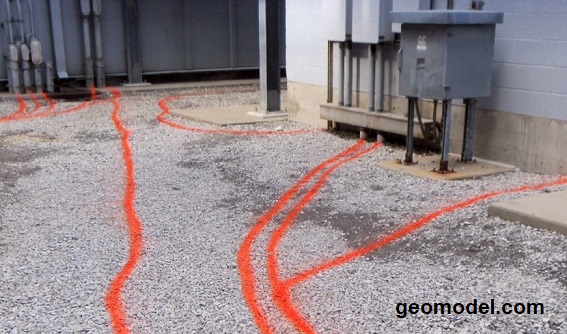How to Locate Underground Utilities
By Matthew Turner, PG
Vice President GeoModel, Inc.
www.geomodel.com
Locating underground utilities should be performed by an experienced licensed professional with many years of locating utilities. Many times, buried utilities are located by people from Low-Cost Locating Companies with only little experience and with limited locating equipment, which can lead to unidentified utilities that will be hit during excavation. Many people have been inconvenienced by cut power lines or hurt, or even killed, by cut gas lines that were not identified by inexperienced locators.
Utility Locator Personnel
You should know something about the person locating your underground utility. This is easy to do. Just ask for your technician’s name and go to your LinkedIn account and type in their name. If they were working at a tire shop two years ago, you may want to reconsider the locating company that you are working with. A good locator should have at least 10 to 20 years locating experience with no hits for active utilities. This will eliminate any questions about his or her qualifications.
GeoModel, Inc. always sends licensed personnel with over 20 years of experience to job sites to locate underground utilities. This practice insures that only a quality locating job will be performed. Low-Cost locating companies will send personnel with just minimal training and limited equipment. On many projects, GeoModel, Inc. has re-surveyed areas where the Low-Cost companies located only a few of the many buried utilities in the area.
Utility Locating Equipment
The quality and number of different types of locating equipment that your locator shows up with is an important factor. Always ask your locator what equipment they will bring to your site. The typical locator will show up with just two methods of locating. This should cause alarm that you just hired the wrong locator. A good locator will bring multiple types of locating equipment.
The equipment that your locator should show up with at your job site include Ground Penetrating Radar (GPR), Electromagnetic Conductivity (EM), Frequency Locator, Magnetometer, Cable Locator and Manhole Locator. If the locating company shows up with anything less than the equipment mentioned above, then hire another company.
Ground Penetrating Radar (GPR) is an important tool for locating underground utilities. GPR can locate non-metallic utilities that other locating equipment cannot. GPR uses different microwave energy frequencies to obtain data from different depths but usually 400-MHz is used for utility location. GPR can determine the approximate size of depth of utilities and performs best in sandy soils and mixed soils, but not as well in clay soils.
Electromagnetic Conductivity (EM) instruments measure the conductivity of the ground and can detect conductive and buried metal utilities. GeoModel owns and uses very accurate EM instruments that can reach depths of up to 18 feet (6 meters) below the ground surface. GeoModel, Inc. uses this deep locating equipment to detect metal utilities, conductive pipes, and most electrical cables.
Frequency Locators are very important for locating buried utilities. If used in the Passive Mode, the frequency locator can detect the energy from buried electric lines or phone lines. Fiber optic lines can also be located with the Frequency Locator. The frequency locator can also be used in Active Mode, where a transmitter is attached to exposed utility lines or other connections to augment the signal received by the frequency locator.
Magnetometers can locate buried iron utilities or ferrous metal related to the buried utilities. The magnetometer is very sensitive and locates very deep utilities.
Cable Locators are designed to locate electric or phone cables. They utilize low or high frequencies to locate cables for a considerable distance.
Manhole Locators can locate buried manholes or metal utility covers that are hidden below ground.
Summary
A good locating company will send experienced, licensed locating personnel with multiple types of locating equipment to your site. Low-Cost locating companies will send a minimally experienced crew to your site with minimum equipment. In the end, for safety considerations and cost-effectiveness, the quality of the locating survey is what counts.
GeoModel Utility Locating Flyer – Click on link to see a .pdf of GeoModel, Inc.’s Utility Locating Methods
